August 7, 2025
Audio overview: Listen & Learn
Ever feel like you're drowning in a sea of software options, all promising to be the "next big thing" for your solar designs? Trust us. We get it.
In the super fast-paced world of solar, having the right design platform is essential. It's like having a superpower that makes your job easier, your designs spot-on, and your customers happier (and your bank account fatter!).
Well, 2025 is in full swing, and the solar design software scene is buzzing with innovation. But with so many shiny
new tools popping up, how do you figure out which one actually delivers for the folks on the ground – the installers like you?
Top 5 Solar Design Software Tools Installers Use in 2025
We’ve compared the best solar design software tools that installers are using in 2025. From quick layout options to in-depth PV modeling, these platforms support solar teams of every size.
We’ll walk you through the real features, limitations, pricing, and who each tool is best suited for—so you can make the right call for your business.
Key Takeaways:
- Efficient software enhances productivity, reduces errors, and accelerates permit approvals.
- Each platform excels in different areas, such as advanced modeling, rapid quoting, or CRM integration.
- Matching software features to your team's workflow and business model is crucial.
Introduction to Solar Design Software
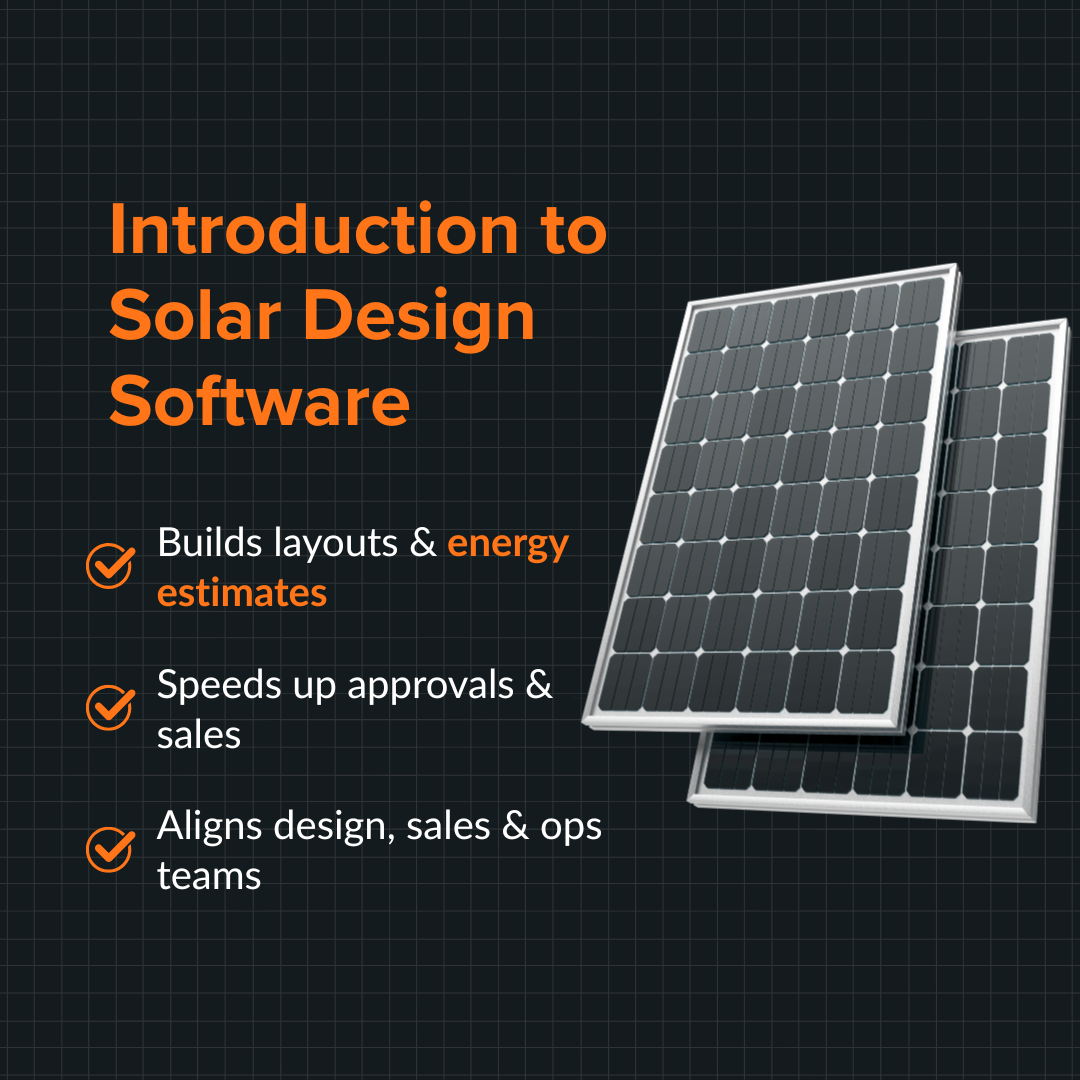
Solar design software is a crucial tool for solar professionals who plan and build photovoltaic (PV) systems. It helps in solar development by allowing users to create accurate system layouts, estimate energy production, and model system performance for both residential and commercial solar projects.
Why It Matters:
- Provides precise energy simulations
- Creates accurate roof or site layouts
- Helps align designs with local codes and regulations
- Shortens the sales-to-install timeline
- Improves communication between sales, design, and operations
Benefits of Solar Design Software
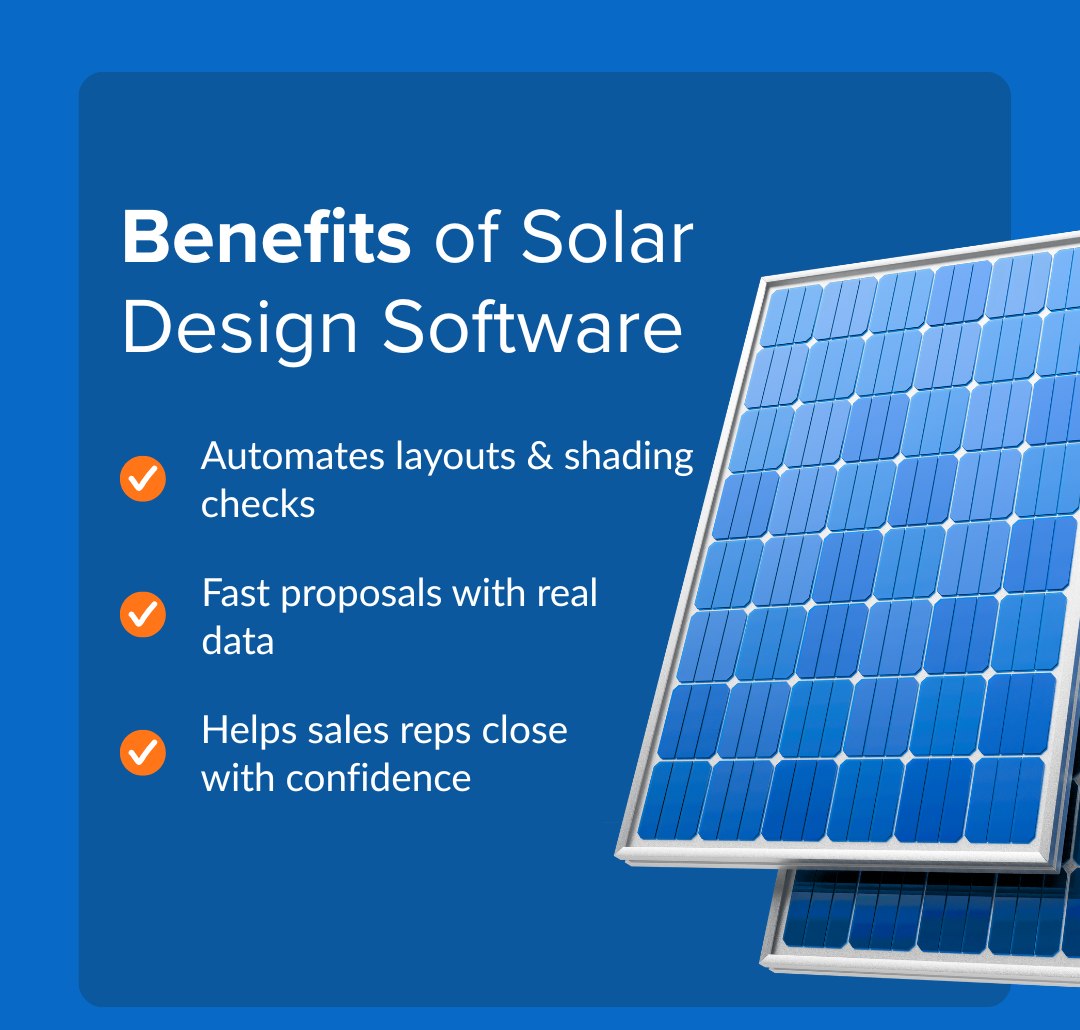
Solar design software enables solar professionals to work more efficiently and effectively. Automating key workflows, such as layout generation, shading analysis, and proposal building, saves time at every stage of the project.
Key Benefits for Solar Companies:
- Automates site assessments and layout planning
- Speeds up lead capture and proposal creation
- Improves accuracy in energy production estimates
- Supports better communication with customers
- Helps sales teams close more deals with confidence
These types of solar software solutions are essential for modern teams seeking to grow efficiently and remain competitive.
Also read: How Solar CRM Software Can Help You Win More Projects
Below, we will review Solar Design Software: Features, Pros, and Best Use Cases. Let's dive deeper!
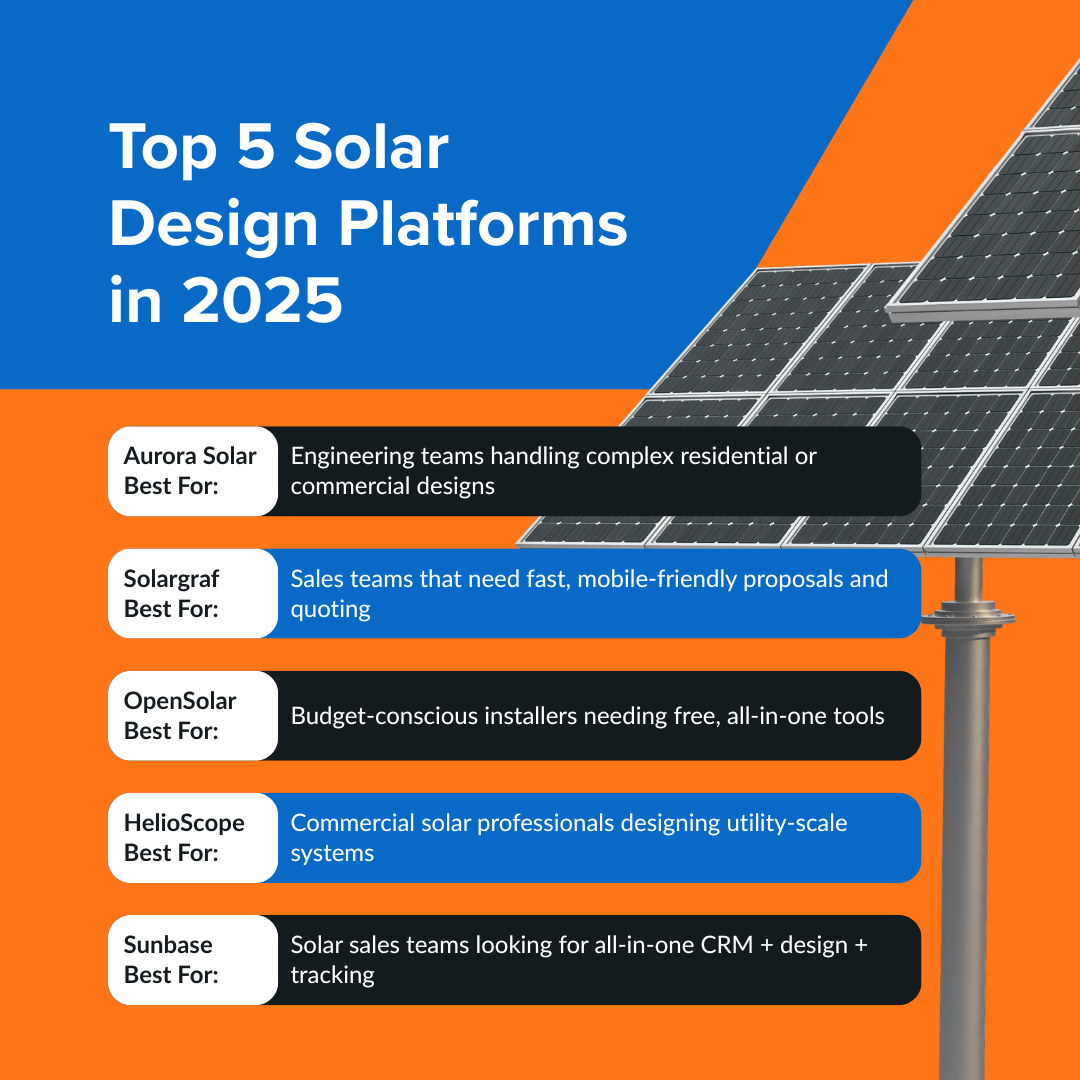
1. Aurora Solar
Aurora Solar is one of the most trusted names in the solar industry, known for its engineering-grade precision. It’s designed for professionals who need advanced tools for system design, shading analysis, and detailed energy simulations, especially for complex residential and commercial projects.
Why Solar Professionals Choose It
- Offers detailed shading analysis and energy simulations for accurate system planning
- Includes advanced 3D modeling to map rooftops, obstructions, and terrain
- Supports accurate photovoltaic system design that meets permitting and engineering requirements.
- Generates designs that align with industry standards and permitting requirements
- Provides permit-ready documentation for AHJs and utility interconnection approvals
Things to Consider
- Primarily focused on system design and engineering, not a complete sales platform.
- Best used alongside other tools to manage the complete end-to-end solution
- May require more onboarding time for small teams or newer solar businesses
- Significant learning curve for new users
- High cost may not suit small businesses
- Requires reliable internet; limited offline functionality
Best For:
Aurora Solar is a top choice for solar professionals and engineers who prioritize accuracy and work on high-volume or complex installs. It’s especially effective for teams that already use separate platforms to manage the sales process and customer interactions.
2. Solargraf
Solargraf is a fast and user-friendly solar design software, built for speed and simplicity. Designed with sales teams in mind, it enables solar professionals to create proposals quickly, perform basic system layouts, and close deals more efficiently, without requiring in-depth technical skills.
Why Solar Professionals Choose It
- Easy-to-use interface built for fast solar proposal creation
- Let users complete quotes and system layouts in minutes
- Includes integrated financing options and e-signature tools
- Mobile-friendly, ideal for reps working in the field
- Built-in CRM features for managing leads and customer data
- Supports residential and commercial projects with streamlined workflows
Things to Consider
- Not suitable for utility-scale projects or engineering-heavy designs
- Customization of proposals and reports can be limited
- More suited for sales-driven teams than design-heavy operations
- Works best with internet access; not designed for offline use
Best For:
Solargraf is ideal for solar installers, sales teams, and smaller solar companies that value speed, simplicity, and mobile access. It’s beneficial for teams that need to generate fast quotes, manage leads, and send clean proposals without getting into complex system modeling.
3. OpenSolar
OpenSolar is a free, cloud-based solar design software platform that offers full sales-to-design functionality. Built by former solar professionals, it empowers teams to create proposals, design systems, and manage the sales process, all without a paid license.
Why Solar Professionals Choose It
- 100% free to use with no licensing fees
- Includes layout tools, shading analysis, and energy simulations
- Built-in sales proposal and contract features with e-signatures
- Offers basic CRM capabilities for lead tracking
- Web-based and accessible from anywhere with an internet connection
- Designed with input from installers and solar businesses
- Great for residential and commercial projects
Things to Consider
- Advanced design features are more limited than in tools like Aurora or HelioScope.
- Custom branding and proposal styling options can feel basic
- Some U.S.-specific features (like utility integrations) may be limited
- Lacks high-end modeling for utility-scale projects or commercial engineering
- Mobile experience is less polished compared to paid competitors
- Support resources and onboarding tools may be lighter than premium platforms
Best For:
OpenSolar is ideal for small to mid-sized solar companies, new installers, or growing teams seeking a cost-effective, all-in-one solution. It’s an excellent entry point for those needing core solar software features without the overhead of a paid platform.
4. HelioScope
HelioScope is a powerful solar design software built specifically for commercial and utility-scale PV projects.
Known for its accurate energy simulations and streamlined workflows, it’s a favorite among engineers and teams working on large, complex solar systems.
Why Solar Professionals Choose It
- Excellent for modeling commercial projects and ground mount systems
- Offers detailed shading analysis and long-term energy output forecasting
- Integrates with AutoCAD and other engineering tools
- Simplifies documentation for utility interconnection and financial analysis.
- Fast layout tools for large arrays and multi-MW systems
- Simplifies documentation for utility interconnection and financial modeling
Things to Consider
- Not built for residential projects or small-scale system design
- Requires additional platforms to manage the full sales process
- Limited customization options for non-technical users
- Internet connection required for full functionality
- Better suited to engineers than sales teams
Best For:
HelioScope is ideal for engineers, commercial design teams, and solar companies specializing in utility-scale projects. If your business handles complex layouts or requires highly accurate financial and performance analysis,
HelioScope is one of the most reliable tools available.
5. Sunbase
Sunbase is an all-in-one solar software platform that combines design, sales, CRM, and project tracking in one interface. While its design features are simpler than engineering-focused tools, its strength lies in streamlining the entire solar sales process, from lead capture to signed contract.
Why Solar Professionals Choose It
- Includes built-in tools for proposal generation, quoting, and design
- Supports residential and commercial projects with fast, field-ready workflows
- Enables reps to upload utility bills, site photos, and customer notes from mobile
- Integrated CRM helps track leads, tasks, and project stages
- Automation features improve follow-ups and team accountability
- Designed for speed, clarity, and ease of use, even for small teams
- A proper end-to-end solution for managing the whole customer journey
Things to Consider
- Design tools are streamlined, not suited for detailed engineering or utility-scale planning.
- Focuses on workflow efficiency rather than deep modeling or technical layouts
- Best performance when used as part of the complete Sunbase platform
- May not offer advanced simulation data like Aurora or HelioScope
- Best used by teams prioritizing sales enablement over engineering depth
Best For:
Sunbase is ideal for solar sales teams, contractors, and growing businesses that want to manage everything from proposals to project tracking in one place. It’s a strong fit for those who value simplicity, mobile access, and fast sales turnaround without needing separate software for every stage.
Solar Design Software Comparison Table
Choosing the right platform depends on your team’s needs, whether that’s engineering precision, fast quoting, or
all-in-one functionality. Below is a side-by-side comparison of the five top tools used by solar professionals in 2025.
| Feature / Platform | Aurora Solar | Solargraf | OpenSolar | HelioScope | Sunbase |
|---|---|---|---|---|---|
| Design Depth | Advanced 3D modeling and simulations | Basic layout tools for fast quoting, LiDAR 3D, and improved sim | Solid design tools for free | Commercial/utility-scale precision, C&I 3D, LIDAR | Streamlined for fast residential quotes |
| Shading Analysis | Yes | Yes | Yes | Yes | Yes - 3D Layouts |
| Proposal Generation | Yes | Yes | Yes | Yes | Yes |
| CRM & Lead Tracking | Limited/ Integrations | Yes | Basic | No | Yes |
| Financing Integration | Yes (via partners) | Yes | Yes | No | Yes |
| Mobile Access | Moderate | Strong | Moderate | Moderate | Strong |
| Ideal Project Type | All, esp. technical | Sales-driven, SMB | Small to mid-sized installs | Utility & large commercial | Fast-turnaround residential & SMB |
| Pricing | Paid | Paid | Free | Paid | Paid |
| Best For | Engineers, technical teams | Sales reps, small sales teams | Budget-conscious teams | Commercial designers | Sales-driven teams & contractors |
This breakdown should help you match your business needs to the tool that supports your workflow, rather than forcing you to adjust your process to fit the software.
Choosing the Right Solar Design Software
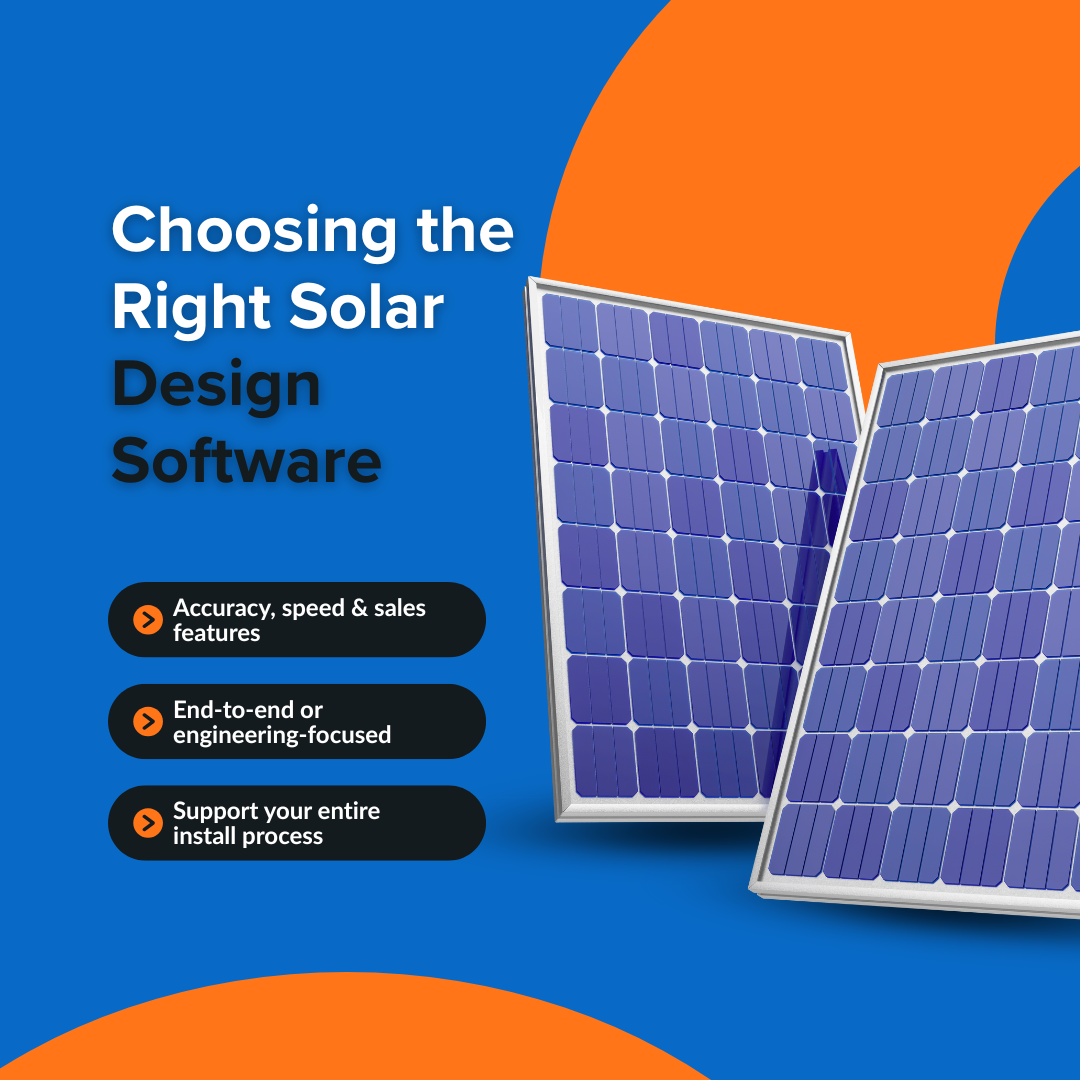
The right solar design software can make or break your workflow. With an endless number of options available on the market, it can become quite overwhelming; however, selecting a platform that aligns with your business model is crucial to achieving long-term success.
Key Considerations for Solar Professionals:
- Includes shading analysis, energy simulations, and accurate system design tools
- Provides end-to-end solutions, from proposal generation to permitting documentation
- Delivers highly accurate energy output estimates and enables comprehensive financial analysis for informed decision-making.
- Accounts for shading effects, roof tilt, weather data, and real-world variables
- Supports residential, commercial, and utility-scale solar projects
When you choose a platform that aligns with industry standards and supports your entire design process, your team can deliver better proposals, improve accuracy, and close more deals, regardless of your company’s size or structure.
Also read: Guide to Choosing the Best Solar CRM in 2025
About Sunbase
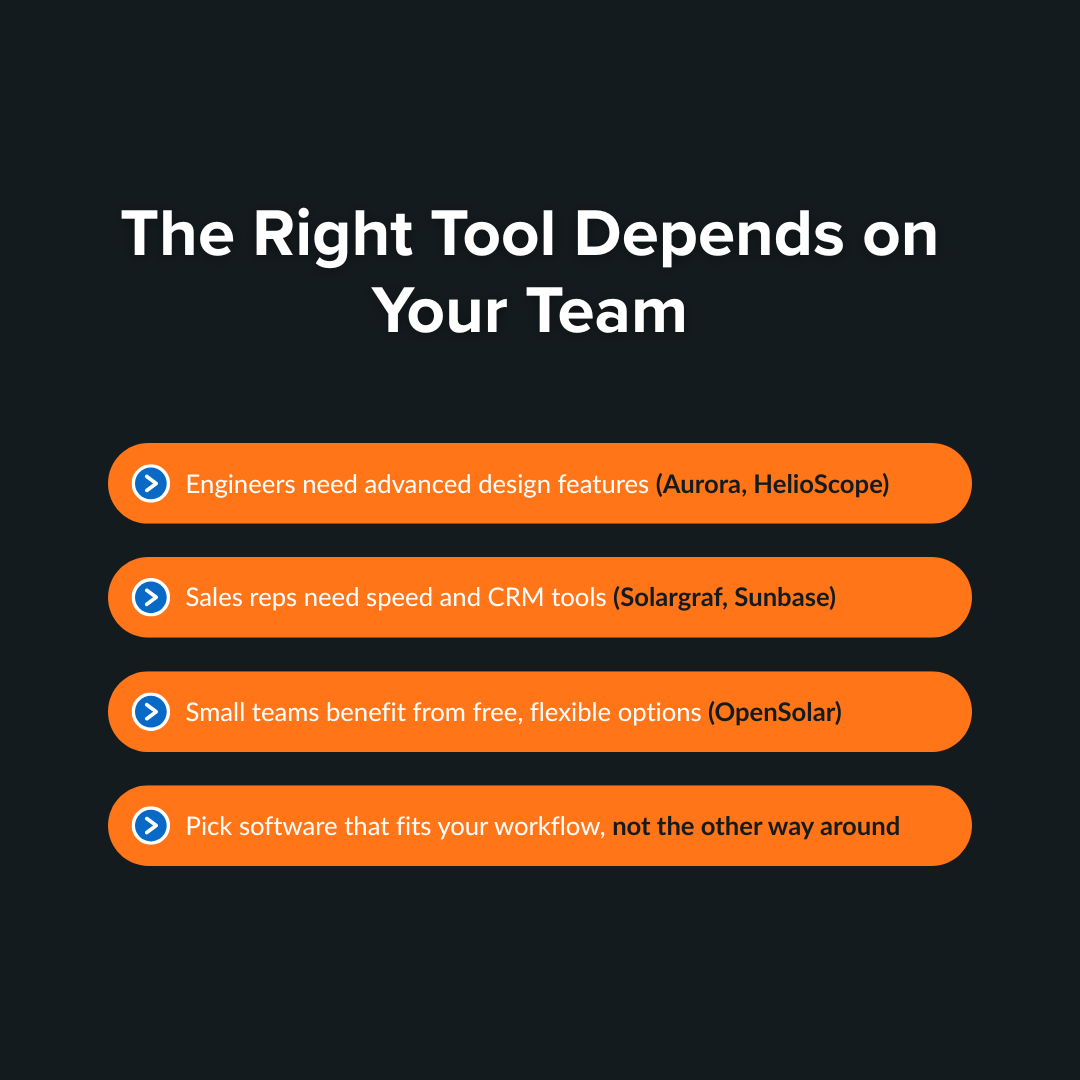
Sunbase is an all-in-one platform built for solar sales, design, financing, and project management. It helps teams streamline their workflows, reduce manual tasks, and manage the entire customer journey in one place.
Trusted by growing solar companies across the U.S., Sunbase enhances efficiency, boosts close rates, and eliminates the need for multiple disconnected tools.
Check out: Maximizing ROI with All-in-One Solar Software
Summary
Choosing the best solar design software depends on your business needs, budget, and project volume.
With Aurora Solar's precision, Solargraf's speed, OpenSolar's flexibility, HelioScope's in-depth analysis, and
Sunbase's streamlined all-in-one experience, the market undoubtedly offers strong options. But the right solution is the one that best aligns with your team's needs and processes.
The right platform can help you create faster proposals, reduce mistakes, boost efficiency, and scale your solar business with confidence.
Book a Demo Today
Ready to streamline your sales process and design smarter solar systems?
Book a demo with Sunbase to see how top solar companies are using one platform to manage proposals, projects, and customers, without the hassle of switching between tools.
See how Sunbase can help your team close more deals, save time, and scale your solar business with confidence.
FAQs
1. What is the best solar design software for residential projects?
Aurora Solar and Sunbase are great for residential projects. Aurora offers advanced 3D modeling, while Sunbase makes it easy for sales reps to quote, design, and send proposals—all in one app.
2. Can I use OpenSolar for free?
Yes. OpenSolar is one of the only free solar design tools that includes proposal templates, CRM features, and system design tools. It’s a good option for startups or solo installers.
3. What if I need both sales and engineering tools?
If you need both, consider combining Aurora for technical design with a CRM like Sunbase for sales tracking and automation, or choose a platform like Sunbase that integrates design and CRM capabilities.
I agree to receive marketing messaging from Sunbase at the phone number provided above. I understand data rates will apply, and can reply STOP to OPT OUT.







